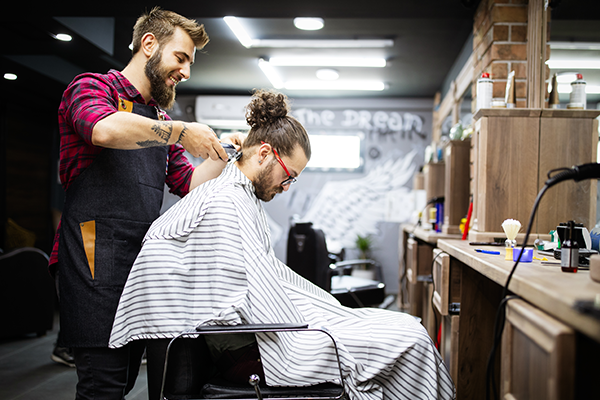Do you love doing your hair? Are you interested in a career that will let you express your creativity? Does working in a fun and social team environment appeal to you? Your passion and natural talent could add value to the exciting world of hairdressing!
Becoming a hairdresser in Australia is a pretty straightforward process. First, you must complete a Certificate III in Hairdressing at a qualified TAFE. Once you have finished your training, you will need to apply for a state-issued hairdresser license or certificate of registration. This will enable you to start working as a professional hairdresser.
In this article, we will discuss what hairdressing is, starting by exploring the typical hairdresser's duties and tasks. We will also help map out your journey to becoming a hairdresser, which starts with getting a hairdresser qualification at TAFE Gippsland.
Once you’ve decided to take the leap, it’ll be time to figure out how to get a hairdressing apprenticeship. Hairdressing apprenticeships are key to taking your beauty career to the next level. We’ll explain how long these learn-while-you-earn opportunities take before you’re raking in a full hairdresser’s salary. Read on to learn everything you need to know about entering this creative industry!

What is hairdressing?
Cut and colour, anyone? Hairdressing actually encompasses a range of activities related to cutting, styling, colouring, and treating hair. It also includes providing advice and assistance to clients by suggesting the best looks for them. Hairdressers offer services such as perms, straightening, and hair extensions. If clients have special needs or dry/damaged hair, a variety of hair treatments can be utilised, such as deep conditioning treatments, hot oil treatments, hair masks, keratin treatments, and more.
Beyond traditional beauty salons, hair and beauty services are also required in a variety of other industries. Some additional fields where hairdressers are needed include:
- Spas - Hairdressing services such as scalp massages, hair treatments, and styling can be used to help relax clients and give them a more luxurious spa experience.
- Film and television - Hairdressers are often employed in the film and television industry to help with the styling of actors for certain roles.
- Theatre - Hairdressers can be used to help create a certain style for characters in a play or musical.
- Photography - Hairdressers can help create a certain look for a photo shoot or help with the styling of models.
- Fashion - Hairdressers can create high-fashion looks for a runway show or photoshoot.
- Weddings - Hairdressers can design the perfect hairstyle for the bride and bridal party on their special day.
- Education - Hairdressers can become teachers, educating students about the art of hairdressing through hands-on classes or lectures.
- Health care - Hairdressers can help provide hair care services to those who are ill or recovering from surgery.
- Retail - Hairdressers can work in beauty-related retail stores or department stores, helping customers find the right hair care products and providing styling advice.
Typical hairdresser duties
You might be surprised to learn that some of the everyday tasks carried out by hairdressers include a lot more than just cutting hair. To prepare you for a day in the life of a hairdresser, here are some of their typical everyday duties:
- Greeting clients and general customer service - A hairdresser must greet clients with a friendly and professional attitude in order to make the client feel comfortable and welcome.
- Using a point-of-sale system - Hairdressers are often responsible for transactions with clients and need to be familiar with cash handling and any point-of-sale systems used within the salon.
- Shampooing - This involves cleansing the hair of dirt and product buildup, as well as providing a relaxing scalp massage.
- Conditioning - Conditioning treatments are used to hydrate and nourish the hair.
- Cutting - Hairdressers must use a variety of techniques to cut the hair according to the client's desired look.
- Styling - This involves using curling irons, blow dryers and other styling tools to create the client's desired look.
- Colour - Hairdressers must know how to mix and apply hair colour products to achieve the desired results.
- Updos - Hairdressers must be able to create elegant updos for special occasions.
- Maintaining the salon - This involves cleaning and organising the salon space, restocking supplies and tidying the workstations.
- Product knowledge - Hairdressers must be knowledgeable about the various products and techniques for styling and caring for hair.
Hairdresser qualifications at TAFE Gippsland
If what you’ve read about becoming a hairdresser sounds good, let’s check out your next steps. The following courses are hairdresser qualifications you can enrol in at TAFE Gippsland:
- Certificate II in Salon Assistant - The Certificate II in Salon Assistant course will grant you the knowledge and experience to excel as a salon assistant. You learn how to provide services like shampooing, basic blow drying, setting up workspaces and more. You'll also learn how to communicate effectively with clients while gaining confidence from working within simulated training salons. Upon successful completion of this pre-apprenticeship course, not only can you look forward to an increase in career opportunities, but you’ll also be prepared for further study. For more information about pre-apprenticeships, read TAFE Gippsland’s article here.
- Certificate III in Hairdressing Apprenticeship - The Certificate III in Hairdressing Apprenticeship provides you with the skills and knowledge to become a qualified hairdresser. You will learn techniques such as cutting, colouring, and finishing hair for clients. Furthermore, this certification covers communication within the workplace environment, consulting with clients, selling products/services, and applying various hairdressing services. After completing your apprenticeship, this qualification will grant you many potential employment opportunities, which include working as a senior stylist or even becoming part of the film and television industry!
- Certificate III in Hairdressing Non-Apprenticeship - For those who wish to go the non-apprenticeship route, you’ll still be able to complete a Certificate III in Hairdressing by attending the course on campus. Along with world-renowned training resources, this program will help you gain all the important hairdressing skills you need to progress in the field. For this pathway, it is suggested that you complete a Certificate II in Salon Assistant before commencing the course unless you have completed a different Certificate III level course or already have industry experience.

How to get a hairdressing apprenticeship
Finding a hairdressing apprenticeship in Australia is relatively easy. You can find an apprenticeship by researching local salons, asking friends or family for recommendations, or searching online job boards. Besides these options, you should also make use of TAFE Gippsland’s Skills and Jobs Centre. The Skills and Jobs Centre has professionals available to help you find a hairdressing apprenticeship opportunity that’s right for you.
The value of a hairdressing apprenticeship in Australia is that it allows you to develop your skills while earning an income. Apprentices typically start on an hourly wage and can progress to higher-paying roles as their skills develop. Apprenticeships also provide an opportunity to network with experienced professionals in the industry, gain a nationally recognised qualification, and access the latest industry trends. For more details about apprenticeships in general, check out this informative article from TAFE Gippsland.
How long is a hairdressing apprenticeship?
A hairdressing apprenticeship in Australia typically takes up to three years to complete. The average timeline for an apprenticeship includes the following stages:
- Initial training - This is usually done at a salon or a registered training organisation (RTO). During this stage, the apprentice will gain the necessary skills to perform basic hairdressing services. This typically takes around six to twelve months to complete.
- Employer-based training - During this stage, the apprentice will continue to learn the more advanced skills required to work as a hairdresser. This stage is completed on the job and takes anywhere from eighteen months to two years to complete.
- Assessment - During this stage, the apprentice will be assessed to make sure they have the necessary skills and knowledge to become a qualified hairdresser. This stage typically takes up to six months to complete. Once the apprentice has completed these stages, they will be able to obtain their hairdressing qualification.
Hairdresser salary: how much do hairdressers earn?
The average yearly salary of a qualified hairdresser is $58,000. Salaries will fluctuate with the level of experience and location within Australia. Entry-level positions start at $54,000 and senior hairdressers can make close to six figures!
Before entering the workforce as a qualified hairdresser, you’ll need to work as an apprentice first. The average wage for hairdresser apprentices is $18 per hour. Wages will depend on the age of the apprentice and will increase as you gain more professional experience.
In conclusion, hairdressing is an exciting career path for those looking to express their creativity and work in a fun team environment. To become a qualified hairdresser, you must complete the relevant qualifications through TAFE Gippsland, such as the Certificate II in Salon Assistant and Certificate III in Hairdressing Apprenticeship/Non-Apprenticeship program.
One of the best ways to learn is through an apprenticeship and TAFE Gippsland will help you find one! The average length of an apprenticeship is three years, with entry-level wages starting at $18 per hour before progressing to higher-paying roles earning up to six figures as a senior stylist. If you’re ready to start your journey to becoming a hairdresser, contact TAFE Gippsland today!